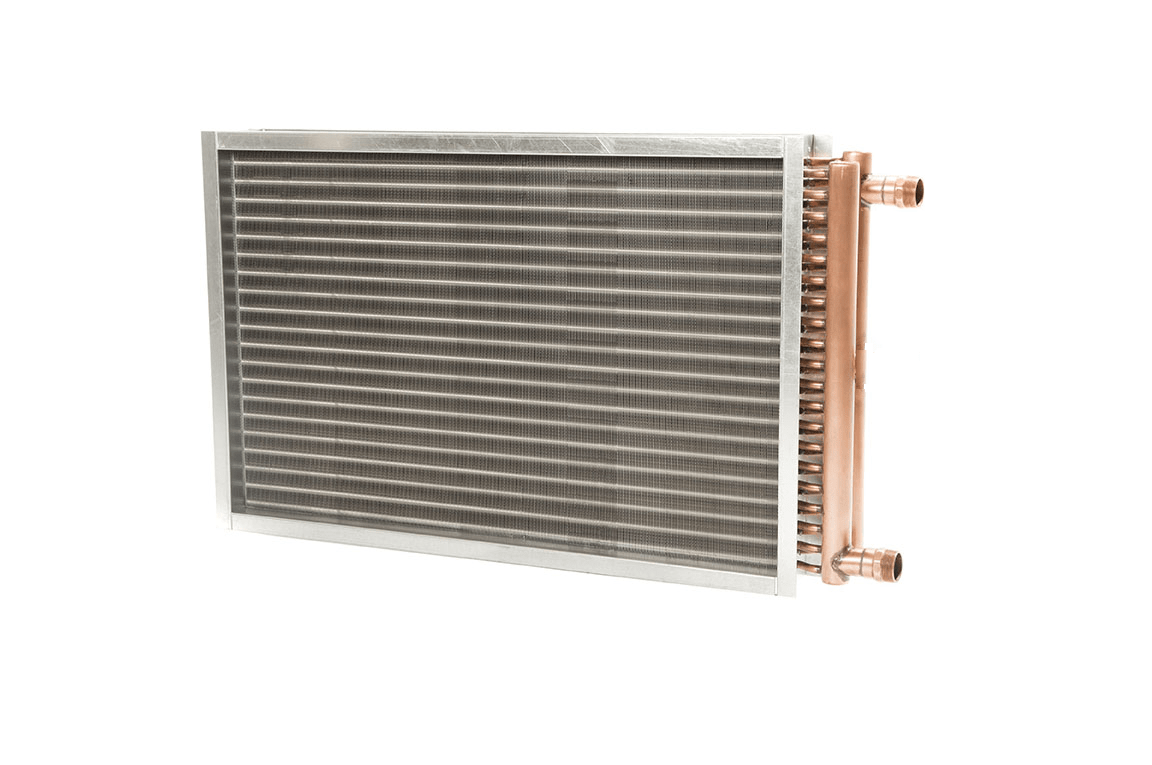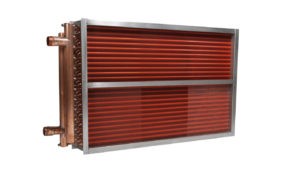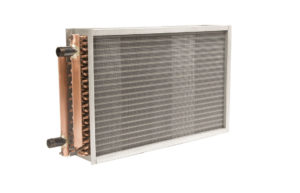
Water Cooling and Heating Coils
Water Cooling and Heating Coils
Water is the most widely used heat transfer medium because it’s readily available and low in cost. Water can be used as a heat transfer medium if the temperature range is between 15 degrees Fahrenheit (when mixed with glycol) when cooling and a high of 210 degrees Fahrenheit when heating.
Chilled Water Coils
When maintaining an acceptable living or working condition in a large commercial space, you are more than likely to encounter a chilled water system versus a refrigerant cooling system. Chilled water coils respond to the cooling effect of surfaces when moisture is condensed from the air in most regions of the United States. The sum of sensible and latent heat transferred by a dehumidifying coil represents the total heat values. Sensible heat transfer is the cooling down of the dry bulb temperatures. For example: An 80-degree Fahrenheit dry bulb being cooled to a 58-degree Fahrenheit dry bulb. There is a latent load, and that is the wet bulb temperatures associated with the dry bulb temperatures at design conditions. For example: A 67-degree Fahrenheit wet bulb cooled down to a 57-degree Fahrenheit wet bulb. If the wet bulb (related to relative humidity) is present, then the moisture must be removed to obtain the designed dry bulb temperature. When the amount of moisture needs to be dehumidified, it may require a lower than desired dry bulb temperature since it gets lowered in the dehumidifying process.
Low humidity areas in the country have dry cooling and rarely have enough moisture to require dehumidification. The operational cost to dehumidify is far more expensive than dry cooling per degree of cooling.
Moisture carry over can be a problem in dehumidifying systems. Air velocity over 550 feet per minute creates condensate that forms on the fin tube surface during the dehumidifying process and can be carried downstream past the unitary drain pan and into fan sections and other parts of the HVAC system. We have seen supply ducts with water in them from carry over. Carry over can also be caused by air stratification and lack of proper safe-offs that allows water in pans to be carried downstream.

Hot Water Heating Coils
Hot water heating coils are used to heat air for specific heating applications. Hot water heating coils, due to the ability of the water to freeze, will generally be found in the reheat position. Air temperatures should never be below 35 degrees Fahrenheit. Majority of hot water heating coils are in ductwork and take preheated air from an intermediate temperature to a final zone temperature required by system controls.
Preheat water heating coils usually require a mixture of glycol to properly operate with below freezing air temperatures. There are many preheat systems in the United States that have water only preheat coils, and there must be failsafe controls to shut these systems down if there is a mechanical failure. For example: If a pump or valve has a failure which stops water flow, then the air side to the system must shut down immediately or there will be freeze damage to the coil. The glycols used are ethylene and propylene, and a designated percentage of mixture will create protection down to the design low ambient temperature.

Required Selection Information
Air Volume: CFM at temperature and altitude
Air Temperatures: Air entering and desired air leaving DB and WB temperatures
Water Volume: GPM and percentage and type of glycol, if required
Water Temperatures: Inlet and desired outlet water temperatures
Coil Size: Available finned area or overall area in height and length in inches
Maximum Water Pressure Drop: Stated in “feet of water”
Maximum Air Pressure Drop: Stated in “inches of water”
Coil Construction: Tubes, fins, headers, connections, and casing
Arrangement: Same end or opposite end connections, right or left hand
Water coils are a mainstay in commercial HVAC systems. Modern day coil selection programs provide you with answers, but it’s imperative that the designer, installer, and owner be educated about the selection and operating details for these types of coils.
